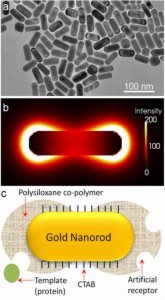Home > Press > Plasmonic biosensors with artificial antibodies
 |
| a) TEM image of gold nanorods; b) electric field distribution at the extinction maximum of the longitudinal SPR band; and c) illustration of imprinted nanorod with siloxane copolymer preferentially grown at the ends. |
Abstract:
The use of localized surface plasmon resonance (SPR) as a platform in biological sensing holds immense promise in delivering devices with superior sensitivity to those of competing technologies. Until now, a major drawback has been that the production of plasmonic biosensors required the use of natural antibodies, making the process expensive and time-consuming. An important step toward overcoming this problem has recently been made, with researchers at Washington University reporting a novel plasmonic biosensor with ‘artificial' antibodies.
Plasmonic biosensors with artificial antibodies
Germany | Posted on November 7th, 2012The biosensor developed is based on very small changes in the SPR spectrum of gold nanorods upon selective binding of a target biomolecule (binding changes the refractive index surrounding the nanorod and thereby shifts the plasmon band). In order to achieve high selectivity, the researchers used the method of macromolecular imprinting to incorporate target species—as a proof-of-concept, several different proteins were used—into a polymer network in close vicinity (several nanometers) to the nanorod. Removal of the target leaves behind a cavity in the polymer, which acts as a ‘lock and key' receptor enabling selective binding of the analyte.
In order to attain maximal sensitivity, it is imperative that the polymer and the molecularly imprinted species are concentrated at the ends of the nanorod. This requirement owes to the fact that the electric field surrounding the nanorod is nonuniform, with the longitudinal resonance being stronger and more sensitive than the transverse (the electric field distribution of the longitudinal resonance is shown in figure panel (b)). This was achieved with the help of a surfactant (CTAB), which is known to adsorb preferentially at the sides of the nanorod. Specific chemicals employed to form a bridge between the nanorod and the polymer precursors were then able to interact preferentially with thiol groups on the ends of the nanorod due to the lower surfactant concentration. The result after polymerisation: a peanut shaped polymer-nanorod with the majority of the polymer and reversible template inclusions (i.e., artificial antibodies) at the ends where the SPR is most sensitivly affected by analyte binding (see figure panel (c)).
To demonstrate the viability of their biosensor in a real-world system, the researchers successfully detected recombinant human neutrophil gelatinase-associated lipocalin (NGAL), a urinary biomarker of acute kidney injury, with detection limits lower than those of conventional analytical techniques. Although emulating the performance of natural antibodies does remain a challenge, the authors suggest ways this could be achieved, meaning we are likely to hear a lot more about these novel biosensors in the near future.
####
For more information, please click here
Copyright © Wiley-VCH Materials Science Journals
If you have a comment, please Contact us.Issuers of news releases, not 7th Wave, Inc. or Nanotechnology Now, are solely responsible for the accuracy of the content.
| Related Links |
![]() Link to the original paper on Wiley Online Library:
Link to the original paper on Wiley Online Library:
| Related News Press |
News and information
![]() Simulating magnetization in a Heisenberg quantum spin chain April 5th, 2024
Simulating magnetization in a Heisenberg quantum spin chain April 5th, 2024
![]() NRL charters Navy’s quantum inertial navigation path to reduce drift April 5th, 2024
NRL charters Navy’s quantum inertial navigation path to reduce drift April 5th, 2024
![]() Discovery points path to flash-like memory for storing qubits: Rice find could hasten development of nonvolatile quantum memory April 5th, 2024
Discovery points path to flash-like memory for storing qubits: Rice find could hasten development of nonvolatile quantum memory April 5th, 2024
Nanomedicine
![]() New micromaterial releases nanoparticles that selectively destroy cancer cells April 5th, 2024
New micromaterial releases nanoparticles that selectively destroy cancer cells April 5th, 2024
![]() Good as gold - improving infectious disease testing with gold nanoparticles April 5th, 2024
Good as gold - improving infectious disease testing with gold nanoparticles April 5th, 2024
![]() Researchers develop artificial building blocks of life March 8th, 2024
Researchers develop artificial building blocks of life March 8th, 2024
Sensors
Discoveries
![]() Chemical reactions can scramble quantum information as well as black holes April 5th, 2024
Chemical reactions can scramble quantum information as well as black holes April 5th, 2024
![]() New micromaterial releases nanoparticles that selectively destroy cancer cells April 5th, 2024
New micromaterial releases nanoparticles that selectively destroy cancer cells April 5th, 2024
![]() Utilizing palladium for addressing contact issues of buried oxide thin film transistors April 5th, 2024
Utilizing palladium for addressing contact issues of buried oxide thin film transistors April 5th, 2024
Announcements
![]() NRL charters Navy’s quantum inertial navigation path to reduce drift April 5th, 2024
NRL charters Navy’s quantum inertial navigation path to reduce drift April 5th, 2024
![]() Discovery points path to flash-like memory for storing qubits: Rice find could hasten development of nonvolatile quantum memory April 5th, 2024
Discovery points path to flash-like memory for storing qubits: Rice find could hasten development of nonvolatile quantum memory April 5th, 2024
Nanobiotechnology
![]() New micromaterial releases nanoparticles that selectively destroy cancer cells April 5th, 2024
New micromaterial releases nanoparticles that selectively destroy cancer cells April 5th, 2024
![]() Good as gold - improving infectious disease testing with gold nanoparticles April 5th, 2024
Good as gold - improving infectious disease testing with gold nanoparticles April 5th, 2024
![]() Researchers develop artificial building blocks of life March 8th, 2024
Researchers develop artificial building blocks of life March 8th, 2024
|
|
||
|
|
||
| The latest news from around the world, FREE | ||
|
|
||
|
|
||
| Premium Products | ||
|
|
||
|
Only the news you want to read!
Learn More |
||
|
|
||
|
Full-service, expert consulting
Learn More |
||
|
|
||








